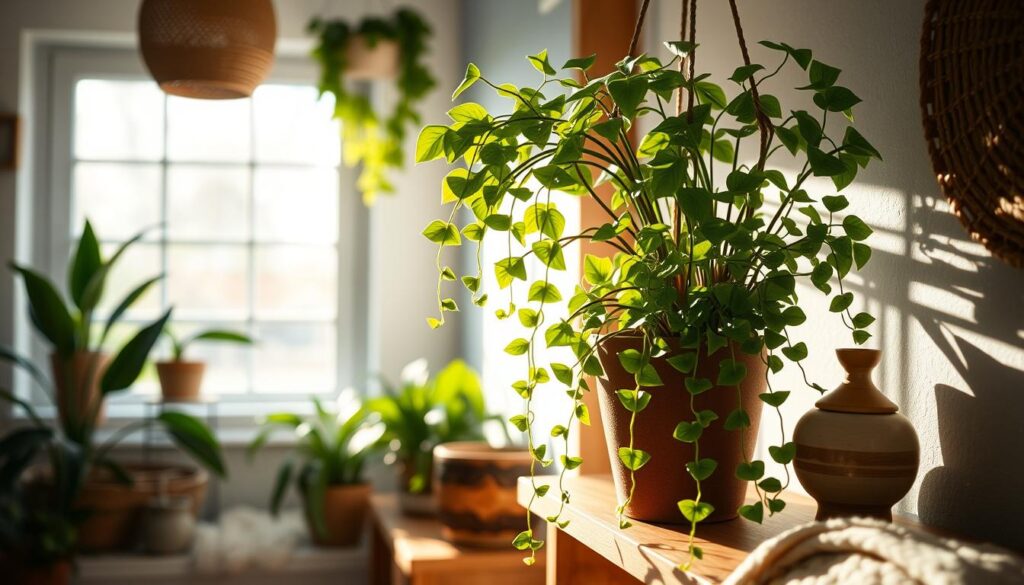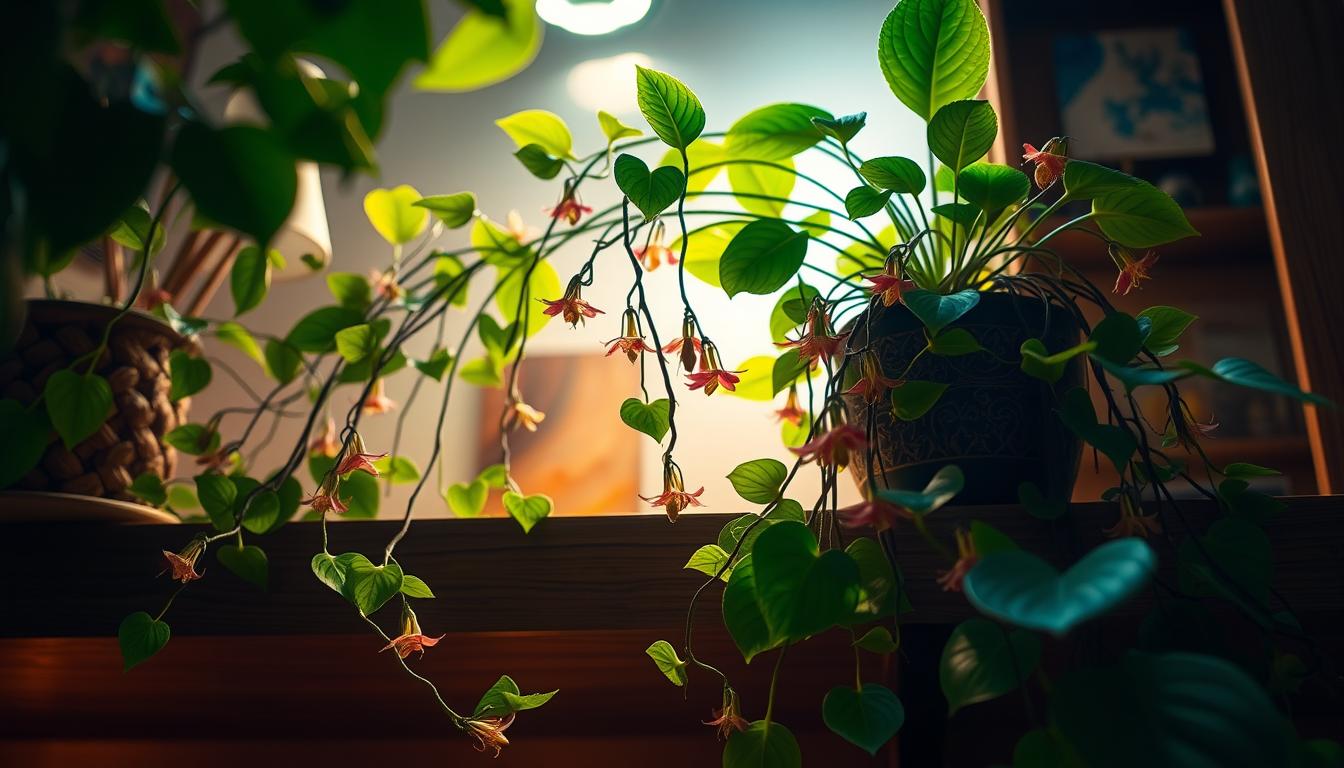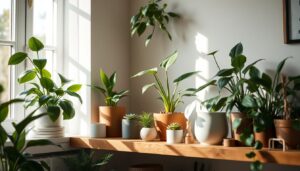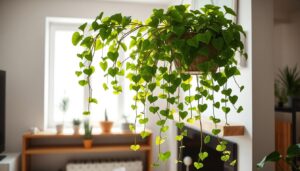When it comes to indoor gardening, Hoya care is a topic that sparks excitement among plant enthusiasts. With their cold-tolerant and trailing nature, Hoya plants have become a popular choice for many. As we delve into the world of Hoya plant care indoors, it’s essential to understand the unique needs of these beautiful plants, including their Wax Plant light needs.
Whether you’re a seasoned plant lover or just starting your indoor garden journey, understanding the basics of Hoya care is crucial for their growth and blooming. From watering and fertilizing to pruning and propagating, each aspect of Hoya plant care plays a vital role in their overall health and well-being.
Key Takeaways
- Understand the importance of Hoya care for indoor gardening
- Learn about the unique needs of Hoya plants, including their light requirements
- Discover the benefits of Hoya plant care indoors, such as low maintenance and beautiful blooms
- Get familiar with the basics of Wax Plant light needs and their impact on growth
- Explore the world of Hoya plant care and its relevance to your indoor garden
- Start your journey to becoming a Hoya plant care expert and enjoy the beauty of these trailing plants
- Find out how to create a thriving indoor garden with Hoya plants as the centerpiece
Understanding Hoya Plants and Their Varieties
Hoya plants are a diverse group, with over 200 species to choose from, making them a great option for low-light flowering plants. They are known for their waxy leaves and fragrant flowers, which can range in color from white to pink to red. To ensure optimal growth, it’s essential to understand the unique characteristics of each variety and follow proper Hoya watering tips.
When it comes to Growing Hoya indoors, some popular varieties for home growers include Hoya carnosa, Hoya kerrii, and Hoya pubicalyx. These varieties are known for their beautiful flowers and ease of care. Here are some key characteristics of these popular varieties:
- Hoya carnosa: known for its fragrant flowers and ability to thrive in low-light conditions
- Hoya kerrii: popular for its heart-shaped leaves and sweet-scented flowers
- Hoya pubicalyx: recognized for its beautiful, fragrant flowers and ease of care
By understanding the unique needs of each variety, you can provide the best care and enjoy the beauty of these low-light flowering plants. Whether you’re a seasoned gardener or just starting out, Growing Hoya indoors can be a rewarding experience with the right knowledge and Hoya watering tips.
With proper care and attention, your Hoya plant can thrive and provide you with beautiful flowers and a unique addition to your indoor garden.
The Ideal Environment for Your Hoya
To create a thriving environment for your Hoya plant, it’s essential to understand its specific needs. Hoya plants are known for their Fragrant indoor plants blooms and can tolerate a range of conditions, but they prefer bright, indirect light. When it comes to temperature, Hoya plants have a notable Hoya temperature tolerance, thriving in temperatures between 65-75°F (18-24°C).
Sunlight Requirements for Hoya
Hoya plants can tolerate low-light conditions, but they will produce more blooms in brighter light. Placing your Hoya plant near an east- or west-facing window is ideal. Avoid direct sunlight, which can cause the leaves to become scorched.
Optimal Temperature and Humidity Levels
Hoya plants prefer daytime temperatures between 65-75°F (18-24°C) and nighttime temperatures around 55-65°F (13-18°C). They also thrive in humidity levels between 40-60%. You can increase the humidity around your plant by placing it on a tray filled with water and pebbles.
Choosing the Right Potting Mix
Choosing the right potting mix is crucial for your Hoya plant’s health. The mix should be well-draining and rich in organic matter. A mix specifically designed for tropical plants or orchids is a good option. Avoid using regular potting soil, as it can retain too much water and cause root rot.
Watering Your Hoya: Best Practices
Proper watering is essential for the health and well-being of your Hoya plant. When it comes to Growing Hoya indoors, it’s crucial to understand the right Hoya watering tips to avoid common mistakes. Overwatering can lead to root rot, while underwatering can cause the leaves to become dry and brittle.
To ensure your Hoya plant thrives, it’s essential to monitor its watering needs. Here are some key factors to consider:
- Check the soil moisture by sticking your finger into the soil up to the first knuckle.
- Water your Hoya plant when the top inch of soil feels dry to the touch.
- Avoid getting water on the leaves to prevent fungal diseases.
By following these Hoya watering tips and adjusting your watering schedule according to the season, you can help your Hoya plant flourish. Remember, Growing Hoya indoors requires attention to detail and a willingness to learn and adapt to your plant’s needs.
Fertilizing Your Hoya for Optimal Growth
Fertilizing is a crucial aspect of Hoya plant care indoors, as it provides essential nutrients for healthy growth and blooming. When it comes to Wax Plant light needs, fertilization plays a significant role in ensuring the plant receives the necessary nutrients to thrive in various lighting conditions.
Types of Fertilizers to Use
There are several types of fertilizers available, including synthetic and organic options. Synthetic fertilizers provide a quick boost of nutrients, while organic fertilizers offer a more natural and sustainable approach. For Hoya plant care indoors, a balanced fertilizer with equal amounts of nitrogen, phosphorus, and potassium is recommended.
Fertilizing Schedule Recommendations
A fertilizing schedule is essential to ensure your Hoya plant receives the necessary nutrients. During the growing season (spring and summer), fertilize your Hoya plant once a month. In the fall and winter, reduce fertilization to once every two months.
Natural Fertilizer Options
Natural fertilizer options, such as compost tea and worm casting, are excellent alternatives to synthetic fertilizers. These options provide a slow release of nutrients, promoting healthy growth and reducing the risk of over-fertilization.
- Compost tea: a liquid solution made by steeping compost in water
- Worm casting: a natural fertilizer produced by worms as they break down organic matter
By following these fertilizing tips and considering the specific Wax Plant light needs, you can provide your Hoya plant with the necessary nutrients for optimal growth and blooming.
Propagating Hoya Plants Successfully
Propagating Hoya plants is a great way to share plants with friends and family or to create new plants for your own collection. One of the benefits of Hoya plants is that they can thrive in low-light conditions, making them ideal Low-light flowering plants for indoor spaces.
To propagate Hoya plants, you can use various Hoya propagation methods, including stem cuttings, leaf cuttings, and air-layering. Each method has its own advantages and disadvantages, and the choice of method depends on the specific variety of Hoya plant and the desired outcome.
Recommended Methods for Propagation
- Stem cuttings: This method involves cutting a section of the stem from the mother plant and rooting it in a potting mix.
- Leaf cuttings: This method involves cutting a leaf from the mother plant and rooting it in a potting mix.
- Air-layering: This method involves making a small incision in the stem of the mother plant and rooting it in a potting mix while still attached to the mother plant.
Timing for Taking Cuttings
The best time to take cuttings from Hoya plants is during the spring and summer months when the plant is actively growing.
Caring for New Cuttings
New cuttings require careful attention to ensure they establish themselves successfully. This includes providing the right amount of water, light, and nutrients.
| Propagation Method | Success Rate | Time to Root |
|---|---|---|
| Stem Cuttings | 80-90% | 2-3 weeks |
| Leaf Cuttings | 50-60% | 3-4 weeks |
| Air-layering | 90-100% | 1-2 weeks |
Dealing with Common Hoya Pests and Problems
As with any plant, Hoya plants can be susceptible to pests and diseases, which can be detrimental to their health and overall appearance. Proper Hoya care is essential in preventing these issues. When it comes to Hoya plant care indoors, it’s crucial to be aware of the common pests that can affect these plants.
Identifying Common Pests
Some common pests that can infest Hoya plants include mealybugs, spider mites, and scale. These pests can cause damage to the plant’s leaves and stems, leading to discoloration, distortion, and even death. Regular inspection of the plant is necessary to identify any potential pest issues early on.
How to Prevent Pest Issues
To prevent pest issues, it’s essential to maintain good Hoya care practices, such as providing adequate light, water, and nutrients. Isolating new plants, pruning infested areas, and using insecticidal soap or neem oil can also help prevent the spread of pests.
Solutions for Fungal Problems
Fungal problems, such as root rot and leaf spot, can also affect Hoya plants. To address these issues, it’s essential to adjust the plant’s environment, such as reducing watering frequency or improving air circulation. Fungicides can also be used to treat fungal infections. By following proper Hoya care and Hoya plant care indoors guidelines, you can help prevent and address common pests and problems, ensuring your plant remains healthy and thriving.
| Pest/Problem | Symptoms | Solutions |
|---|---|---|
| Mealybugs | White, cottony patches on leaves and stems | Insecticidal soap or neem oil |
| Spider mites | Yellowing leaves, fine webbing on plants | Isolate plant, increase humidity, use insecticidal soap |
| Root rot | Soft, mushy roots, yellowing leaves | Reduce watering frequency, improve air circulation |
Pruning Your Hoya: When and How
Pruning is a crucial aspect of Hoya plant care, as it helps maintain the plant’s shape, promotes healthy growth, and encourages blooming. With proper pruning techniques, you can enjoy the beauty of your Hoya plant while also ensuring its optimal growth. When it comes to pruning, it’s essential to consider the Hoya temperature tolerance, as this can affect the plant’s response to pruning.
As a fragrant indoor plant, Hoya plants require regular pruning to prevent them from becoming leggy. Pruning also helps to encourage branching, which can lead to more blooms and a fuller plant. To prune your Hoya plant, start by removing any dead or damaged leaves or stems. This will help prevent the spread of disease and encourage healthy growth.
- Promotes healthy growth and development
- Encourages blooming and flower production
- Helps maintain the plant’s shape and appearance
- Removes dead or damaged leaves and stems
By pruning your Hoya plant regularly, you can enjoy the many benefits it has to offer, including its beautiful blooms andfragrantfragrance. With proper care and pruning, your Hoya plant can thrive and become a stunning addition to your indoor garden.
The Beauty of Hoya Blooms
Hoya plants are known for their beautiful, fragrant flowers, which can bloom in a variety of colors. To encourage blooming, it’s essential to provide your Hoya with the right conditions, including proper Hoya watering tips and a suitable environment for Growing Hoya indoors. By following these guidelines, you can create an environment that promotes flowering and enjoy the beauty of your Hoya blooms.
For more information on Hoya care, you can visit the ultimate Hoya care guide, which provides comprehensive tips on watering, fertilizing, and pruning your Hoya plant. Additionally, learning how to identify and prevent overwatering, as discussed on trusted houseplant guide, can help you become a better Hoya plant parent.
To care for your flowering Hoya, make sure to provide it with bright, indirect light and maintain a consistent temperature between 65-75°F (18-24°C). With the right care and attention, your Hoya plant will thrive and produce beautiful, fragrant blooms.
Common Myths About Hoya Care
When it comes to Hoya care, there are many myths and misconceptions that can lead to confusion and poor care. As a Hoya plant care indoors enthusiast, it’s essential to separate fact from fiction to provide the best possible care for your plant. Proper Hoya care involves understanding the plant’s needs and avoiding common mistakes.
Debunking Watering Myths
One common myth about Hoya care is that the plant needs to be watered frequently. However, this is not the case. Overwatering is a common mistake that can lead to root rot and other problems. To provide proper Hoya plant care indoors, it’s essential to allow the soil to dry out slightly between waterings.
Misconceptions About Light Needs
Another myth about Hoya care is that the plant requires direct sunlight to thrive. While Hoyas do need bright light, direct sunlight can be too intense and cause the leaves to become scorched. East- or west-facing windows are ideal for Hoya plant care indoors, providing the right amount of light without the risk of scorching.

Understanding Growth Patterns
Understanding the growth patterns of your Hoya plant is crucial for providing proper care. Hoyas are climbing plants and need support to grow upwards. Providing a trellis or other support can help your Hoya plant thrive and promote healthy growth. By following these tips and avoiding common myths, you can provide the best possible Hoya care for your plant.
| Hoya Care Tip | Description |
|---|---|
| Watering | Allow soil to dry out slightly between waterings |
| Lighting | Provide bright, indirect light |
| Support | Provide a trellis or other support for climbing |
Why Every Plant Lover Should Own a Hoya
Hoya plants are a true delight for any indoor gardener. With their unique aesthetic appeal, low-maintenance requirements, and resilience, these captivating plants are a must-have for every plant enthusiast. Their trailing vines and eye-catching blooms make them a statement piece that can instantly elevate the look of any indoor space.
Unique Aesthetic Appeal of Hoya
Hoya plants offer a distinctive look that sets them apart from many other houseplants. Their waxy, sometimes variegated leaves and intricate, star-shaped flowers create a mesmerizing visual display. Whether cascading from a hanging basket or adorning a shelf, Hoya plants bring a touch of tropical elegance to any indoor environment.
Low Maintenance and Resilience
One of the best things about Hoya plants is their low-maintenance nature. They thrive on neglect, making them an excellent choice for busy plant owners or those with limited experience. Hoya plants are incredibly resilient, able to tolerate various lighting conditions and adapt to different watering schedules. This makes them perfect for those seeking an easy-to-care-for addition to their indoor garden.
Making an Impact with Your Indoor Garden
By incorporating Hoya plants into your indoor garden, you can create a visually stunning and air-purifying oasis. Their versatility allows them to be used as focal points, cascading displays, or complementary accents to other houseplants. Whether you’re a seasoned plant parent or just starting your indoor gardening journey, a Hoya plant is sure to make a lasting impression.





Pingback: Rubber Plant: The Resilient Houseplant That Can Withstand Cool Indoor Temperatures
Pingback: The Ultimate Guide to Houseplants: 100 Best Indoor Plants for Every Home - Trusted House Plant Guide
Pingback: How to Propagate Snake Plants: Step-by-Step Guide - Trusted House Plant Guide
Pingback: Dealing with Drooping Stems: How to Support and Revive Indoor Plants - Trusted House Plant Guide
Pingback: How to Water Succulents Indoors: A Beginner's Guide to Prevent Overwatering - Trusted House Plant Guide
Pingback: Plant Trends to Watch: Innovations Shaping the Future of Indoor Gardening - Trusted House Plant Guide
Pingback: Smart Gardening: Top Tech Tools for Effortless Indoor Plant Care - Trusted House Plant Guide
Pingback: Cultivating Green Serenity: A Guide to Indoor Palm Tree Care - Trusted House Plant Guide
Pingback: What are the best low-maintenance indoor plants? - Trusted House Plant Guide
Pingback: The Hottest Houseplant of 2025: A Stunning Variety You Need to See - Trusted House Plant Guide
Pingback: 10 Statement Houseplants to Create Your Dream Indoor Jungle - Trusted House Plant Guide
Pingback: 10 Best Air-Purifying Houseplants for a Healthier Home - Trusted House Plant Guide
Pingback: Mastering Fiddle Leaf Fig Propagation: A Guide to Cultivating Lush Greenery - Trusted House Plant Guide
Pingback: Peace Lily Care in Cool Conditions: How to Keep This Air-Purifying Plant Thriving
Pingback: "ZZ Plant Magic: Easy Steps to Lush, Healthy Growth" - Trusted House Plant Guide
Pingback: 12 Best Houseplants for Beginners to Brighten Your Home - Trusted House Plant Guide
Pingback: "What Are the Best Low Light Indoor Plants? Discover 10 Perfect Varieties. - Trusted House Plant Guide
Pingback: The Ultimate Beginner's Guide to the Most Wanted Indoor Plant for 2025 - Trusted House Plant Guide
Pingback: 8 Best Pet-Friendly Houseplants for a Happy Home - Trusted House Plant Guide
Pingback: 10 Perfect Small Houseplants for Compact Spaces - Trusted House Plant Guide
Pingback: 10 Stunning Large Indoor Plants for Statement Decor - Trusted House Plant Guide
Pingback: 12 Stunning Indoor Succulents and Cacti for Your Home - Trusted House Plant Guide
Pingback: 8 Stunning Flowering Indoor Plants to Brighten Your Home - Trusted House Plant Guide
Pingback: Best Flowering Houseplants: Beautify Your Home - Trusted House Plant Guide
Pingback: 10 Gorgeous Houseplants That Thrive in Humidity - Trusted House Plant Guide